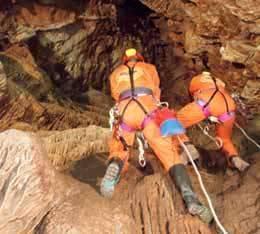|
Peania Village

Paeania Cave Physical Entrance |
Welcome to Peania!
This village is situated not far from the new airport at Spata, just below Mt. Hymettos, with several interesting sights to see. The region itself, called Mesogia, is an agricultural plain with olive groves, vineyards, pine forests, sheep, and a wild life sanctuary. With beautiful natural landscape, clean fresh air, and good access to the airport, the city of Athens, and the ports of Piraeus and Rafina, this is a good area to explore while staying in or around Athens.
One of the main attractions of the village is the newly discovered (1926) Koutouki cave, which is situated on the eastern slope of Mt. Hymettos, only four kilometers from Peania, also spelled Paeania. It is one of the best vertical caves in Greece, of approximately 4,000 square meters in size. Entering the cave you will be fascinated by the scenery; the immense interior of the cave is filled with multicolored pillars, stalactites and stalagmites, and separated into several divisions. The impressive interior is enhanced by the use of artificial light, thus creating an overwhelming atmosphere; the use of classical music makes this natural phenomenon resemble an impressive cathedral.
Visitors are guided through the cave, from entering it to the end of the subterranean tour, across a corridor especially provided for easy access to the interior. Please keep in mind that the entrance you will be using is an artificial one. The physical entrance to the cave is nothing but an opening on the mountain slope. This entrance is still used by people with the relevant experience and equipment, since it involves a rope-climb down to the cave's bottom, at a depth of 38.5 meters (115 feet) (See picture).
Another excellent attraction in the area is the Vorres Museum, an installation occupying 80 acres, with lovely gardens and courtyards. The museum has two main sections and generally covers a period of 4,000 years leading up to the present. The first section of the museum is devoted to Modern Greek art created during the 20th century. The second section is called the "Pyrghi" (or tower) and is composed of a complex of two traditional rural houses, the remains of a stable, and an old wine press dating from the end of the period of Ottoman rule, the early 19th century. The exhibits show furniture, handmade rugs, and articles of every day use during the period. There is also an excellent collection of pottery, oil paintings and engravings, plus finds from the area dating to antiquity.
|
|
|
|



